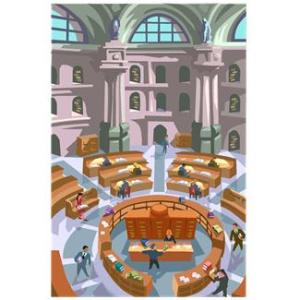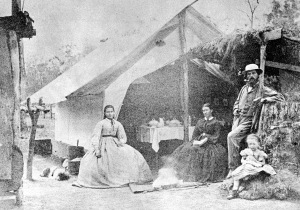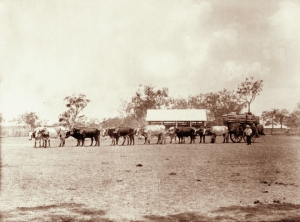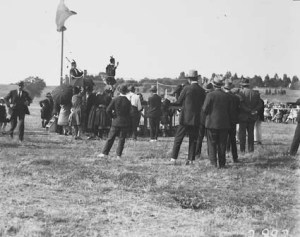 Shauna Hicks has initiated a new 52 week series of prompts, Genealogy Records. We’re only into Week 3 but there have already been some interesting topics: Military Medals, Internal Migration and Probate.
Shauna Hicks has initiated a new 52 week series of prompts, Genealogy Records. We’re only into Week 3 but there have already been some interesting topics: Military Medals, Internal Migration and Probate.
Over the past few years I’ve done several 52 week series: Personal Genealogy and History (2011), Abundant Genealogy (2012) and my own Beyond the Internet (2012). I’m currently signed up for Angler’s Rest’s Book of Me 15 month series as well, with which I’m very much behind. Combined with various A to Z April posts and other daily or monthly posts I’m reluctant to get involved in more as it starts to feel like I’ve got a tiger by the tail.
However Shauna’s topic is a great opportunity to personalise my own stories to her theme so I will probably join in from time to time where the topic is relevant to my own history. I have such a migration mania that I couldn’t possibly not participate in her second topic, Internal Migration. Whenever I get on the topic of migration it turns into a long yarn, so grab a coffee and a comfy chair, and read on for a while.
THE McSHARRY/McSHERRY FAMILIES
With so many railway people in my family tree, it’s inevitable that they’d be a peripatetic lot. Some moved across vast distances, others only relatively short postings when in their early years.

My greatest internal migrants would be the Sherry family who arrived in Rockhampton, Queensland, from Ireland where they also worked on the railway: the Dublin, Wicklow and Wexford Railway line judging on their progressive movement through those counties. On arrival, the patriarch James Sherry, changed most of the family’s name to McSharry. Oral history suggests this may have been to piggy-back on the fame of James McSharry from the railway construction firm, O’Rourke and McSharry. Who knows whether this is fact or fiction. I suppose it’s also possible that the two families may have been connected but that’s an exploration I’ve yet to undertake. Whatever the reality it has certainly caused immense confusion when trying to unravel what happened to my own family over the years, especially the mystery of what happened to my James McSharry.
The McSharry family moved from Rockhampton where they arrived, to Maryborough (why?) for a number of years, then back to Rockhampton where wife/widow, Bridget McSharry, settled and ran a boarding house until her death in 1900.
The adult children of this family moved around Queensland in response to work. Early family events revealed at least some of these through death certificates, police staff files, Post Office Directories, electoral rolls, and marriage records.
The eldest son of the family, Peter Sherry, arrived with his family a year after the rest of the Sherry family. Strangely he changed his name to McSherry rather than McSharry. Within weeks of arriving in Rockhampton he had been recruited to Queensland Government Railways and so began his migration around the state. The family spent a long time in Longreach, then moved on to Hughenden and Townsville before being transferred to Rockhampton where they put down roots.
Tracing this family’s internal migration has been greatly facilitated by Trove as it has revealed stories that would otherwise never have been known. I have a full copy of Peter’s railway staff record which tells the bare bones of his positions and postings over the years: a great base for knowing where they migrated internally.
Obviously the children of this family moved with Peter and Mary McSherry in their childhood, but even in their adulthood, the migrations continued. My grandfather James, worked in Hughenden then later Townsville before moving to Brisbane so his children could obtain jobs, or so the oral history goes. Given the move occurred in 1942, mid-war, in the thick of the Brisbane Line concept, I have to wonder whether it was because he was needed to build the railway carriages further from risk of Japanese invasion.
Once again my sources are: railway staff files, Trove, oral history.
THE KUNKEL FAMILY
George and Mary Kunkel, of whom you’ve all heard often, settled in Ipswich after their marriage there in 1857. While there George worked in a number of occupations: servant (pre-marriage), pork butcher and boarding house keeper. To all extents and purposes he was there all the time, after all there were children being born at regular intervals.

It was a court report, that enlightened me differently. While the family was settled, George was also working on the Tooloom goldfields in northern NSW as a butcher. Further reading on Trove revealed that there were regular coaches between Tooloom and Ipswich so plainly he could get home fairly often, perhaps to restock his supplies.
Recently I posted how he’d had a financial setback and this may have prompted their move westward, reportedly working on the railway, or perhaps again supplying meat. The next precise confirmation of where they lived was at Highfields, via the school admission registers and through church baptisms and birth certificates.

A few years later and the family would move a short distance to the Fifteen Mile between Highfields and Murphys Creek where they would take up farming and settle. George supplemented the farm income by working for the railway as a labourer.
Kunkel descendants, many of them railway workers, also moved around south-east Queensland and west as far as Roma with postings as the railway was constructed. One family branch moved to Mackay in northern Queensland and set down roots cane farming.
Records: court reports, school admission records, baptisms and birth certificates, railway staff files, land selection records.
THE GAVIN FAMILY
The Gavins were short-migration people. Denis came from Kildare in Ireland and his wife, Ellen, from Wicklow. They married in Dublin before they emigrated though it’s not known when they each made that internal move.

On arrival Denis went to Binbian Downs station (per his obituary) as a carrier, then to Dalby, Toowoomba and Crows Nest. Although the distances are short by Australian standards he would have covered a lot of ground carrying wool on the bullock dray from Binbian Downs which is out near Wallumbilla.
Like the other Gavan/Gavin families with whom they interweave, but are unrelated, they remained on the Darling Downs.
Records: Convict records (the Galway Gavins), birth certificates, employment records, death certificates, re-marriage certificates, obituaries, maps, Trove.
THE KENT, PARTRIDGE AND McCORKINDALE FAMILIES
These families were my stay-at-homes. The Kents and Partridges both went straight to Ipswich on arrival as far as I can tell. There they remained until their deaths, though descendants moved around the state.

The McCorkindale exodus from Glasgow commenced with Peter and Duncan’s arrival in Sydney in 1900. Well actually I eventually discovered it commenced with an uncle’s arrival quite a bit earlier. After the death of their father, their mother (Annie Sim McCorkindale) emigrated with the rest of the family excluding one stay-put son, Thomas Sim McCorkindale who’d moved to London. Close analysis of the shipping lists showed that other family members had arrived as well.
Once settled in Brisbane on arrival, Peter joined them, and the family remained there except for country excursions to decimate the opposite in bagpipe and Highland Dance competitions. Duncan McCorkindale moved between Sydney and Canberra where he was part of the teams that built the nation’s capital, and their Caledonian Society.
Records: Trove, shipping lists, BDM certificates, church registers.
THE MELVIN FAMILY
Stephen Gillespie Melvin’s family was tied to the sea, with generations of merchant seamen. No surprise then that they were born to be migrants, both internal and international.
After the death of his wife, Janet, soon after arrival SGM settled in Ipswich, Queensland where he promptly established a well-regarded confectionery shop. He must have gadded around a bit though because his land portfolio was scattered around the south east of Queensland. But it was his foray into mining that brought him undone, resulting in insolvency and a little jaunt to jail.
Not long after being released from jail, the family moved to Charters Towers which was then experiencing a gold boom. No doubt escaping his notoriety would have been on his mind as well, though the coverage of the trial was so extensive that it would have been known in Charters Towers as well.
Around the time of his second wife’s Emily’s death, SGM started acquiring businesses and land in Sydney and thus the younger members of his family set down their roots in New South Wales. Meanwhile he continued his migrations on a temporary basis, as he travelled back and forth to the UK for business. One such migration became permanent however when he died in London.
Records: BDM certificates, church registers, shipping records, Trove, court reports, gaol records, insolvency records, wills.
THE O’BRIEN WIDDUP FAMILY
I know from my Irish research that the emigrants were keen to follow their own destiny even at the expense of family connections, but the internal migration of Bridget O’Brien (later Widdup) is one that puzzles me.

If Bridget was in Ipswich with her sister Mary after their long emigration journey, why did she decide to move south to the Albury area, and to Urana? This has always mystified me, since I knew from her death certificate that she’d spent one year in Queensland.
The possibilities seem to be:
- She didn’t like the Queensland environment or climate
- Friends were moving interstate
- She had met her future husband, John Widdup, on the ship as the story goes so she moved to be with him.
- Her employer in Queensland relocated and offered her a position elsewhere.
It’s the Whys of family history research that keep us on our toes.
Records: Death certificates, oral history, Trove
So there you have it…the peripatetic wanderings of my families over the years. It has always seemed to me that having made the long journey to Australia, rather than the comparatively short hop across the Atlantic, they were not daunted by further moves if they satisfied their occupation or life goals.
A fascinating post, Pauleen. Thank you for telling us about this new challenge. However like you I feel I have got involved already this year with enough to keep me “challenged” and have decided not to take part – also I would be repeating much of what I wrote in your excellent “Beyond the Internet” series. I look forward, though, to reading more of your contributions.
LikeLike
Thanks Susan….we’ve all got so many prompt opportunities that we do need to prioritise. I’m not doing the 52 weeks, 52 ancestors for example as I figure I’ve done lots already. Thanks for your kind comment on Beyond the Internet -I really appreciated your supportive and informative posts on your own site talking about Scottish records.
LikeLike
Wow you have some interesting ancestors here! Thanks for participating and I’ve put some links into my own posts as well. I know what you mean about trying to keep up with it all and that includes reading as well as writing.
LikeLike
Yes reading is proving to be a challenge, and commenting even more so! And I’m no longer working full-time as many people are. I enjoyed the topic Shauna…as you can see they got around a bit.
LikeLike
Hi Pauline, today I was searching around on the internet for anything about the Melvin & Co Confectioners at Charters Towers. You see I have a dinner plate with a picture of the shop on it that my mother, Marjorie Ireland, told me was used in the restaurant. My mother’s aunty was your Aunty Emily 🙂 My grandmother was Lucy Melvin (Lucy Ireland) and Emily’s sister who lived in Cairns. Big thrill for me today to read about the family. So good of you to research all this stuff. I know the Kent/Partridge boy also did a lot of research about the family and I believe my sister Shirley has that information somewhere in her files. Anyway my name is Barbara McDermott (Ireland) and I live in Brisbane these days. By the way my mother is still alive!!! She is 93.
LikeLiked by 1 person
Good to hear from you Barbara…I remember meeting (great) Aunty Lucy a number of times as her other sister, Laura, was my grandmother. I’ll email directly. Good genes there to be 93 and her dad was very long-lived too as I recall.
LikeLike